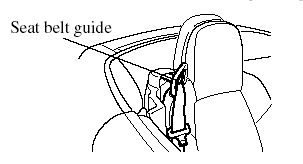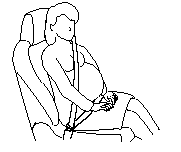Seat Belt Precautions
Seat belts help to decrease the possibility of severe injury during accidents
and sudden
stops. Mazda recommends that the driver and passenger always wear seat belts.
All of the seat belt retractors are designed to keep the lap/shoulder belts out
of the way
when not in use.
The driver's seat belt has no provisions for child-restraint systems and has
only an
emergency locking mode. The driver may wear it comfortably, and it will lock
during a
collision.
However, the passenger's seat lap/shoulder belt retractors operate in two modes:
emergency
locking mode, and for child-restraint systems, automatic locking mode.
Your vehicle is equipped with LATCH lower anchors for securing the LATCH
childrestraint
system in the passenger seat but there is no child-restraint tether available.
As
there is no rear seat on this vehicle, the preferred location for children,
following the
manufacturer's instructions on the LATCH child restraint-system and this owner's
manual is
important.
WARNING:
Always wear your seat belt and make sure all occupants are properly restrained:
Not wearing a seat belt is extremely dangerous. During a collision, occupants
not
wearing seat belts could hit someone or things inside the vehicle or even be
thrown
out of the vehicle. They could be seriously injured or even killed. In the same
collision, occupants wearing seat belts would be much safer.
Do not wear twisted seat belts:
Twisted seat belts are dangerous. In a collision, the full width of the belt is
not
available to absorb the impact. This puts more force on the bones beneath the
belt,
which could cause serious injury or death.
Never use one seat belt on more than one person at a time:
Using one seat belt for more than one person at a time is dangerous. A seat belt
used in this way cannot spread the impact forces properly and the two passengers
could be crushed together and seriously injured or even killed. Never use one
belt for
more than one person at a time and always operate the vehicle with each occupant
properly restrained.
Do not operate a vehicle with a damaged seat belt: Using a damaged seat belt is dangerous. An accident could damage the belt webbing of the seat belt in use. A damaged seat belt cannot provide adequate protection in a collision. Have an Authorized Mazda Dealer inspect all seat belt systems in use during an accident before they are used again.
Have your seat belts changed immediately if the pretensioner or load limiter has
been expended:
If the air bags deploy the corresponding pretensioner(s) may also deploy at the
same
time. Like the air bags, the seat belt pretensioners will only function once.
While it is
safer to use a crash-used seat belt that was used in an accident than no seat
belt at
all, using a seat belt with an expended pretensioner or load limiter loaded
reduces
the safety available to you. If the seat belt pretensioners are not replaced,
the risk of
injury in a collision will increase. Expended seat belt pretensioners and air
bags must
be replaced after any collision which caused them to deploy. Additionally, the
load
limiter will only limit loads on the chest once in a collision and this is
another reason
to have the seat belts inspected. Always have an Authorized Mazda Dealer inspect
the seat belt pretensioners and air bags after any collision.

CAUTION:
Belt retraction may become difficult if the belts and seat belt guides are
soiled, so try
to keep them clean. For more details about cleaning the seat belts, refer to
“Cleaning
the Lap/Shoulder Belt Webbing”.
PregnantWomen and Persons with Serious Medical Conditions

Pregnant women should always wear seat belts. Ask your doctor for specific recommendations.
The lap belt should be worn SNUGLYAND AS LOWAS POSSIBLE OVER THE HIPS.
The shoulder belt should be worn across your shoulder properly, but never across
the
stomach area.
Persons with serious medical conditions also should wear seat belts. Check with
your
doctor for any special instructions regarding specific medical conditions.
Emergency Locking Mode
In the emergency locking mode, the belt remains comfortable on the occupant
and the
retractor will lock in position during a collision. When the seat belt is
fastened, it will
always be in the emergency locking mode until it is switched to automatic
locking mode by
pulling it all the way out to its full length. If the belt feels tight and
hinders comfortable
movement while the vehicle is stopped or in motion, it may be in the automatic
locking
mode because the belt has been pulled too far out. To return the belt to the
more
comfortable emergency locking mode, wait until the vehicle has stopped in a
safe, level
area, retract the belt fully to convert it back to emergency locking mode and
then extend it
around you again.
If the belt is locked and cannot be pulled out, retract the belt once, and then
try pulling it
out slowly. If this fails, pull the belt strongly one time and loosen, then pull
it out again
slowly.
Automatic Locking Mode
To enable seat belt automatic locking mode, pull it all the way out and
connect it as
instructed on the child-restraint system. It will retract down to the
child-restraint system
and stay locked on it. If the LATCH lower anchors are not used alone for LATCH
style
junior seats and infant carriers without tethers, always use the automatic
locking mode to
keep the child-restraint system from shifting to an unsafe position in the event
of an
accident. See the section on child restraint.
See also:
Warning and Beep Sounds
qSystem Malfunction Warning Beep
If any malfunction occurs in the advanced
keyless function, the KEY warning light
(red) in the instrument cluster illuminates
continuously and beep sounds will be
...
The Inside
You might be surprised at how accommodating the Miata's two-seat cabin is for
taller occupants. I stand 6 feet 1 inch tall and was able to get comfortable in
the driver's seat. Someone even a litt ...
Body Lubrication
All moving points of the body, such as
door and hood hinges and locks, should
be lubricated each time the engine oil is
changed. Use a nonfreezing lubricant on
locks during cold weather.
Make sur ...


